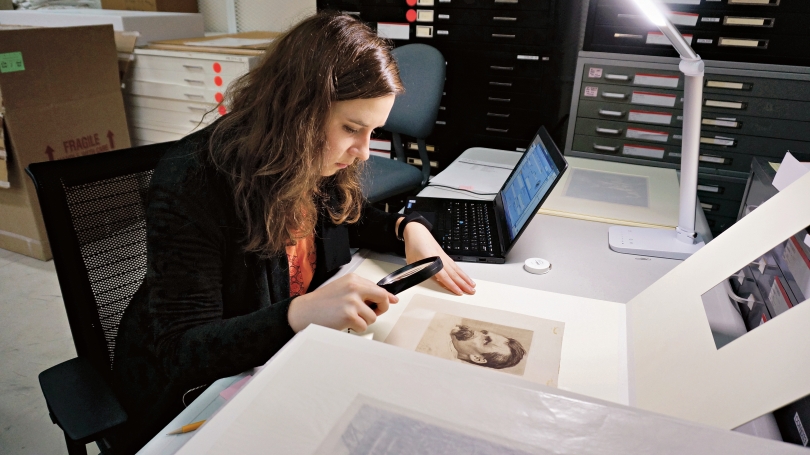Digitization and Cataloguing
During this period of renovation and expansion, Hood staff members are working on some fundamental tasks related to the collection, one of which is its digitization. Put simply, more images of the collection online allow greater access to the museum’s greatest resource—the works of art and material culture it holds in trust. Recently, for example, the museum completed a project funded by a grant from the Institute of Museum and Library Services to digitize about 4,000 objects in its Native American collection.
Building on this initiative, we have begun to capture images of the African collection, with the goal of digitizing the entire holdings in this area by next spring. As of late October 2016, we had taken 1,256 images of 630 objects. In addition, we set up a station for digitizing the print collection, the start of an effort to photograph all of the Hood’s works on paper, one of the richest and broadest areas of the collection. Jeffrey Nintzel, who has worked at Dartmouth and the Hood as a contract photographer since the mid-1970s, is capturing the African works, and a Hood staff team is working with a copy stand on the two-dimensional works with the goal of getting 7,000 works on paper completed by the end of spring term. As of late October 2016, they had already captured 3,525 works. This team effort involves staff from a variety of museum areas, including the registrar’s office (Kathleen O’Malley, Cynthia Gilliland, Rebecca Fawcett), the exhibitions preparations department (John Reynolds, Matt Zayatz, and Sue Achenbach), the external relations area (Katharine Staelin, Alison Palizzolo), and the visitor services/ security area (Christopher Warren).
Digital images are vital parts of the process of teaching with and exhibiting works of art, but the work does not stop there. The museum has also hired Jillian Kruse as a curatorial assistant for two years to help with another important aspect of providing access to the collection: thorough and accurate cataloguing. Jillian has recently worked both at the Museum of Fine Arts, Boston, and the National Gallery of Ireland in Dublin. A crucial part of her review of the cataloguing of each Hood print is the addition of keywords to the subject field. Whether one seeks a print on air warfare during World War I by the American artist John Taylor Arms (aviation/war) or a mythological etching by early German printmaker Henrich Aldegrever about Hercules and Atlas (mythology/trickery), keywords are hugely helpful to any search of the collection according to ideas or topics of broad interest.
These activities will increase the ability of Dartmouth students and faculty to access the Hood collections for the purposes of teaching and learning, making their eventual use of the study rooms in the new Hood’s Center for Object-Based Inquiry that much richer. It will also open up the incredible resource that is the Hood’s collection to the public. This initiative has been made possible by a generous gift from Claire Foerster and Dan Bernstein, Dartmouth Class of 1987.

